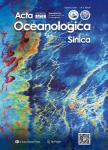Two climate factors in May that affect Korean rainfall in September
Two climate factors in May that affect Korean rainfall in September作者机构:National Typhoon Center Korea Meteorological Administration College of Ocean Science/Ocean and Environment Research Institute Jeju National University
出 版 物:《Acta Oceanologica Sinica》 (海洋学报(英文版))
年 卷 期:2013年第32卷第1期
页 面:32-47页
核心收录:
学科分类:0710[理学-生物学] 0908[农学-水产] 07[理学] 0707[理学-海洋科学] 070601[理学-气象学] 0706[理学-大气科学]
基 金:A grant from "Development of Meteorolocial Resources for Green Growth" and "Research for the Meteorological and Earthquake Observation Technology and Its Application" supported by the NIMR/KMA under contract No.NIMR-2012-B-3 the Korea Research Foundation Grant funded by the Korean Government (MOEHRD, Basic Research Promotion Fund) under contract No. KRF-2007-331-C00255
主 题:anomalous pressure Arctic Oscillation Korea low-level trade wind rainfall tropical cyclone
摘 要:This study revealed a high positive correlation between rainfall in Korea during September and the trade wind (TW)/Arctic Oscillation (AO) index in May that combines two climate factors, low-level TWs and the AO. This correlation was identified on the basis of the difference in the 850 hPa streamline analysis between the positive and negative phases selected using the combined TW/AO index. In May, the spatial pattern of the anomalous pressure systems is similar to that in the positive AO phase. These anomalous pressure sys- tems continue in June to August (JJA) and September, but the overall spatial distribution shifts a little to the south. Particularly in September, a huge anomalous anticyclone centered over the southeast seas of Japan strengthens in most of the western north Pacific region and supplies a large volume of warm and humid air to the region near Korea. This characteristic is confirmed by the facts that during the positive TW/AO phase, the subtropical western north Pacific high (SWNPH) is more developed to the north and that the continu- ous positioning of the upper troposphere jet over Korea from May to September strengthens the anomalous upward flow, bringing warm and humid air to all layers. These factors contribute to increasing September rainfall in Korea during the positive TW/AO phase. Because the SWNPH develops more to the north in the positive phase, tropical cyclones tend to make landfall in Korea frequently, which also plays a positive role in increasing September rainfall in *** above features are also reflected by the differences in average rainfall between the six years that had the highest May Nifio 3.4 indices (El Niflo phase) and the six years that had the lowest May Niflo 3.4 indices (La Nifia phase).



